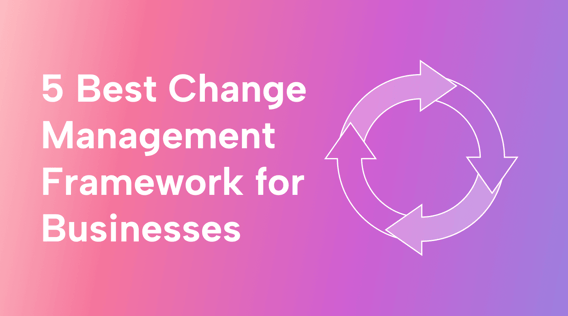2020 taught us many lessons, but most importantly, it taught us that change is inevitable—whether you like it or not.
People, businesses, and economies are still adapting to the changes that COVID-19 brought about. Some of the changes are good, some bad, but most are necessary.
While it’s impossible to plan for the “unplannable,” a change management strategy to help navigate these changes would help.
A change management process helps you implement changes to ease your business (and employees) into the new way of doing things.
In this article, we’ll dive deep into the five best change management frameworks that you can use to help you champion change the right way.
What is change management?
Simply put, it’s a game plan for change. Effective change management helps businesses deal with changes or adjustments of all types.
Change management helps you set expectations with key stakeholders, employees, and project teams to prepare for and embrace changes.
It'd be an understatement to describe this concept as expansive and unrestricted. It's meant to be this way by design.
Why is change management important in business?
Change is inevitable. In fact, 99% of all businesses report that they've had to undergo a major change in the last three years.
Change is unavoidable for an abundance of reasons. Consider the impact of COVID-19, the progress of technology, the worldwide expansion of markets, the evolution of culture, and changing economic trends. If you don’t want to be left behind, embracing change is crucial.
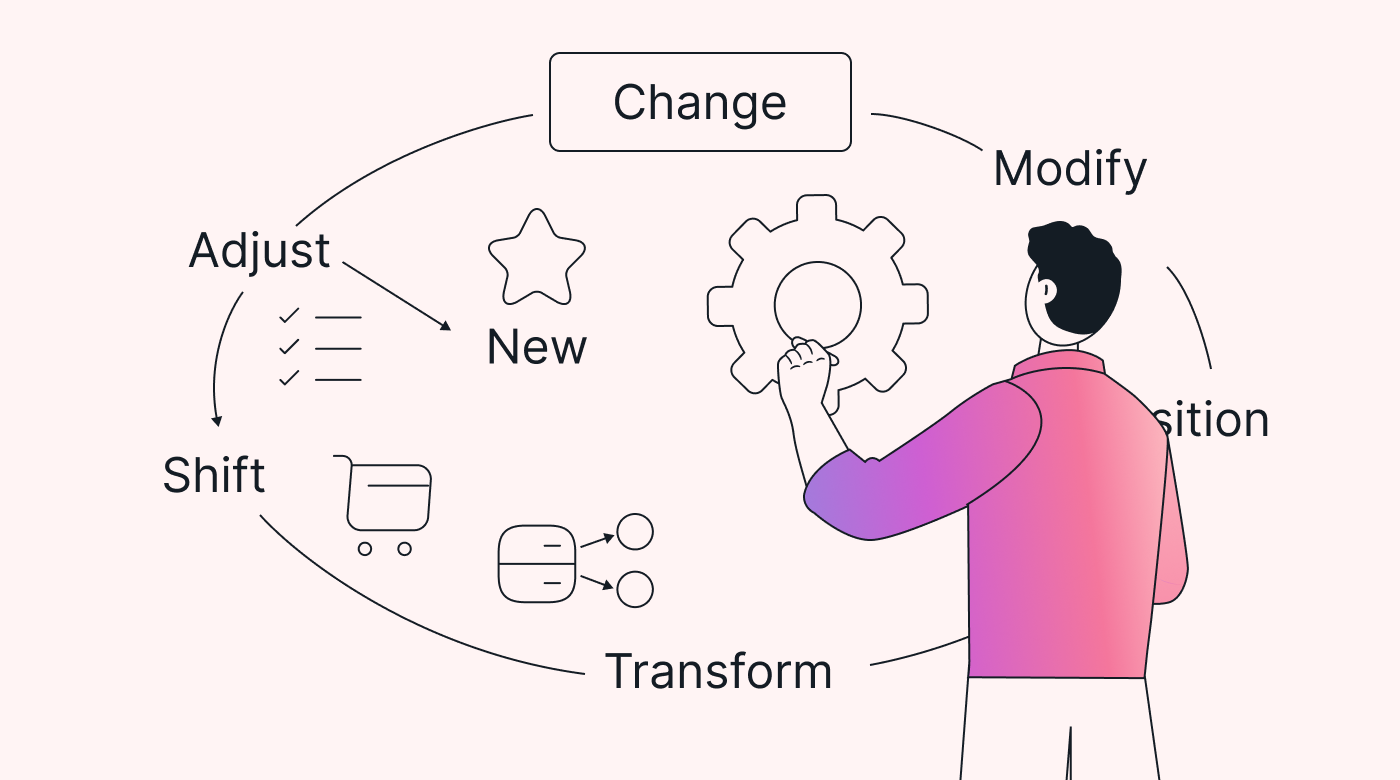 |
A call for change is a good sign since it can show that a business is growing.
But what kind of change are we talking about here? Change may involve:
- Implementing new programs.
- Revamping marketing strategies.
- Enhancing operational workflows.
- Reorganizing human resources.
- Developing fresh ideas.
- Financial matters.
These all fall under the umbrella of organizational change management (OCM), which primarily focuses on the people within an organization.
If you have already made the decision to stir the (change) pot using change management, you have a head start. Read: you are in a better position to make change stick.
What is a change management framework?
A framework is an outline of sorts that helps you build something around it.
Think of the structured approach to building a house. First comes the foundation. Next comes the framework. It's a literal, physical outline to build a house around.
Similarly, an organizational change management framework is the outline to help you build and manage organizational changes. These frameworks also provide the tactics, i.e., steps, practices, and techniques to implement and execute the changes.
With a tried change management framework, you'll have all the components necessary to get buy-in from your team and key stakeholders.
And, rather than reinventing the wheel each time you make a change, these frameworks are a template for implementing change.
5 change management frameworks to help you succeed at transformation
We’ve hand-picked five that work well with SMBs. You can run with one model or a mix of several models. Whatever works best for your business.
Lewin's change management framework
Kurt Lewin is known as the “founder of social psychology” and a pioneer of social, organizational, and applied psychology in the United States.
Lewin's change management model is a three-stage process. He used the analogy of changing the shape of a block of ice to explain his ideas on instilling organizational change in an organization.
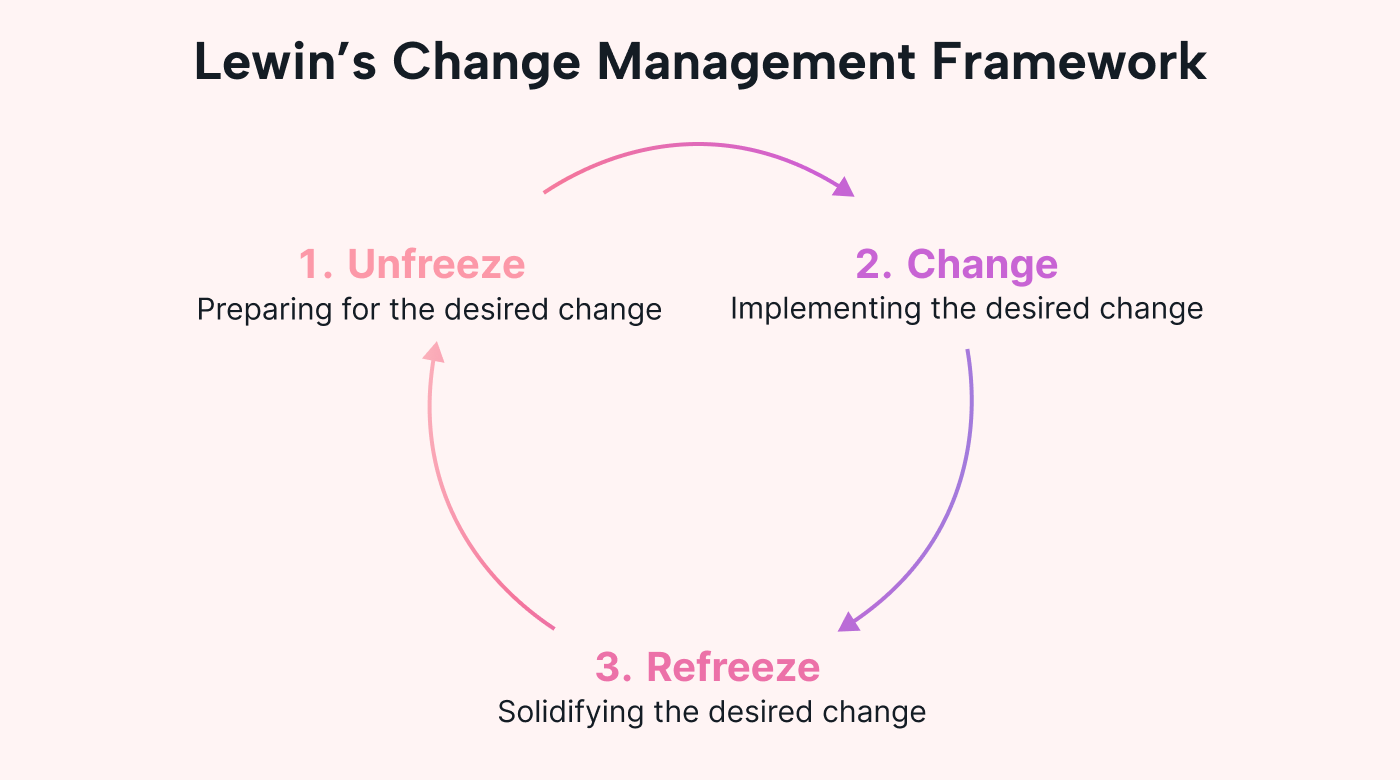 |
Stage 1 — Unfreeze
The initial step is to prepare people to handle the upcoming organizational change. To do this, he emphasizes that you must find ways to prepare employees or stakeholders while creating a sense of urgency.
Stage 2 — Change
The next stage is about implementing the change. Using an Agile approach to iterate through the shift might be easier.
Here are some practical steps you can take to reduce uncertainty and make progress:
- Make sure you have a comprehensive communication plan ready to go.
- Ditto for training plans: make sure they include workshops and exercises to ease into the change.
- Look for easy wins that'll inspire and propel your team forward.
Stage 3 — Refreeze
At this stage, people might start getting comfortable with the change. However, you should stay vigilant and encourage the best practices you’ve built up to keep everyone from slipping into past habits.
Great for implementing completely new wholesale changes.
Let's see how this would look with an example where a bakery wants to implement a new cake delivery service with more cake options:
- During stage 1, look at how you can prepare the bakers for all the new orders. Maybe it's by studying what other bakeries are doing.
- During stage 2, you organize a weekly workshop to help the bakers learn how to incorporate new recipes into existing workflows.
- Then, once the bakers are comfortable with the new recipes, you can easily implement stage 3, where you refreeze the new normal.
PDCA cycle
PDCA is a four-step approach for implementing continuous improvement (a core pillar of Lean). The four key stages are laid out in a circle because this strategy aims to make continuous improvement (change) an ongoing pursuit.
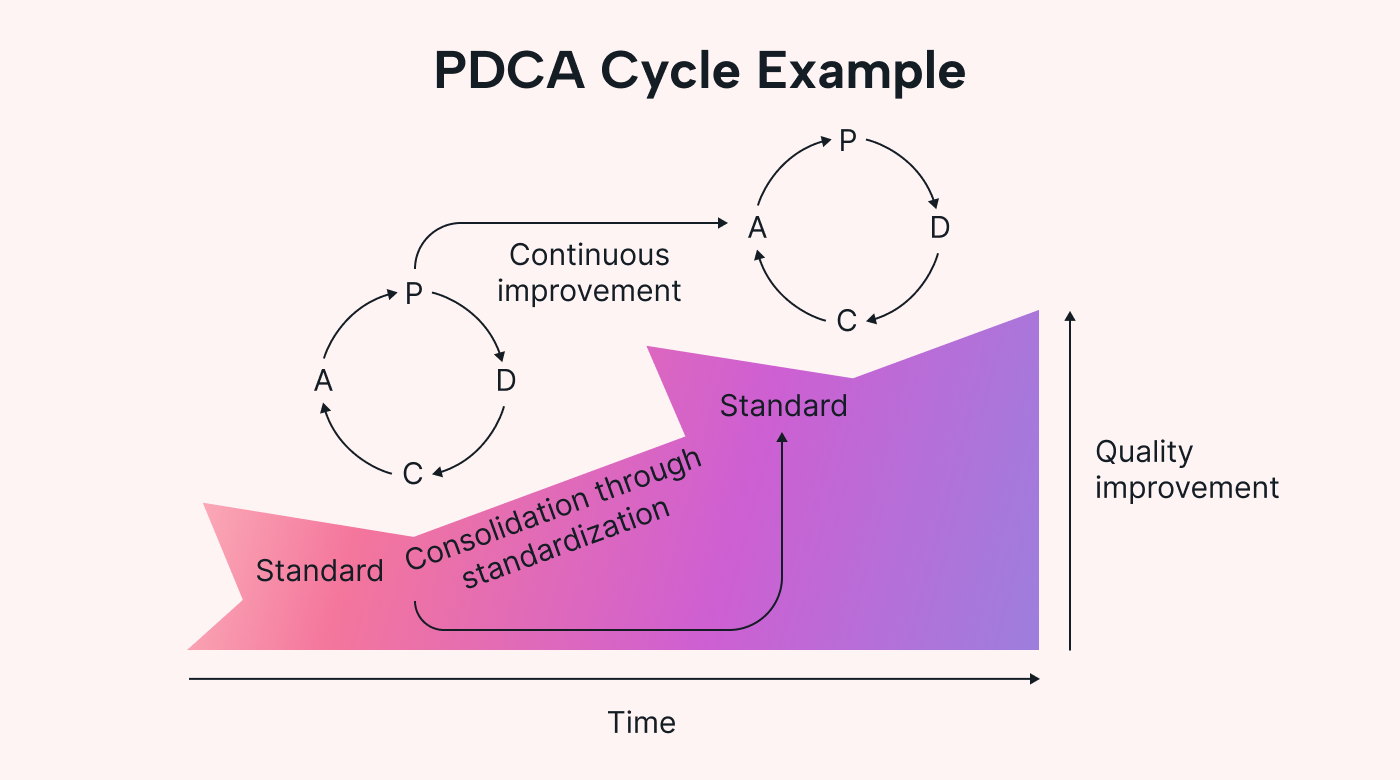 |
The four stages of the PDCA cycle are:
- Plan — set objectives for a process and determine what changes you must make to reach them.
- Do — make the changes.
- Check — assess the performance of the results against a baseline.
- Act — Depending on the outcomes, either standardize the shift or start a new rotation.
Great for refining approaches on a limited scale before implementing larger changes.
For the bakery, this would be a great way to test the new online delivery service. In this scenario, the PDCA in action would look like this:
- Plan — Set targets (to bake more cakes) against a stable baseline (how many cakes they currently bake) of performance.
- Do — Bakers implement new baking methods.
- Check — Gauge the new output relative to the baseline and the goal.
- Act — If you achieve a measurable gain, standardize the new delivery service.
Kotter’s 8-step change management framework
It's impossible to mention change management without Kotter's 8-step process.
John Kotter, a professor at Harvard Business School, is recognized as a specialist in leadership and transformation.
His book, "Leading Change," lays out an eight-part strategy for bringing about changes effectively and is often called the "bible of change."
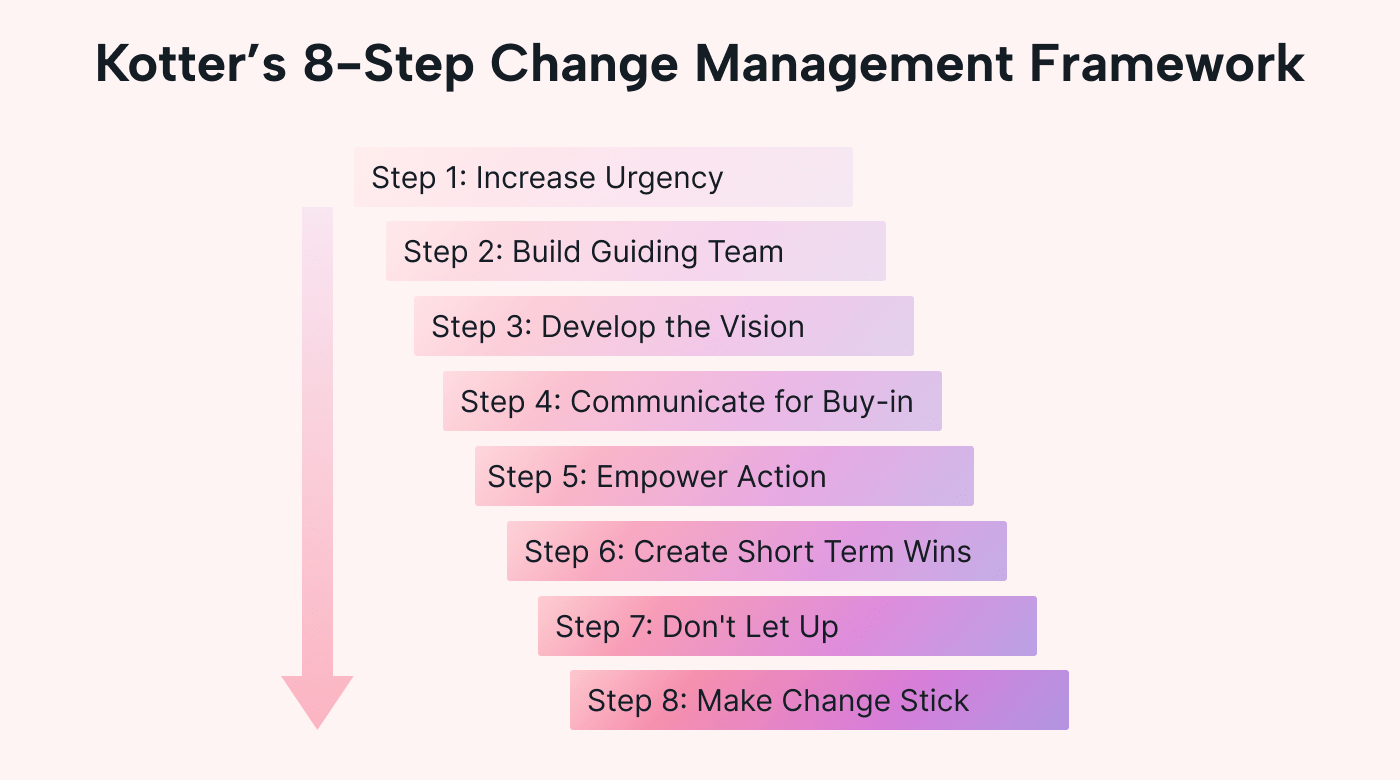 |
Step 1: Increase urgency
The first step of this model is all about creating a sense of urgency for the need to change. Use open and honest dialogue to get people to think about the reasons for the change.
Step 2: Build a guiding team
Build a guiding team out of key stakeholders or influencers in the industry to support the need for change. Ensure they have good interpersonal skills and industry expertise to help guide your change.
Step 3: Develop the vision
Create your change initiative vision. The vision should help align people around a common goal and inspire them to believe they can overcome the change.
Step 4: Communicate for buy-in
Use the vision you created to help get buy-in. Back this up with consistent communication with all stakeholders about the change and its progress.
Step 5: Remove barriers to change
You’ll need to monitor any “change blockers” that might pop up during the change. Some examples are:
- Employee resistance to change
- Old organizational structures
- Outdated tools
- Lack of reward system
Step 6: Create short-term wins
Giving employees short-term wins early and throughout the change process can help them feel like they are achieving something, inspiring them to work harder to embrace the change.
Step 7: Don’t let up
Next, you’ll want to continually analyze success stories and learn from employee experiences to achieve continuous improvement.
Step 8: Make the change stick
Incorporate the change into your company culture.
Great for building acceptability of the change instead of focusing more on the change process.
The bakery could use this model to help prepare the bakers for the new service. You’d focus on the small wins (like learning new recipes) to help the bakers achieve their goals and inspire them to learn more.
McKinsey 7-S model
This in-depth approach, created by the McKinsey consulting firm in the 1970s, measures the effectiveness of how various components of an organization are interrelated.
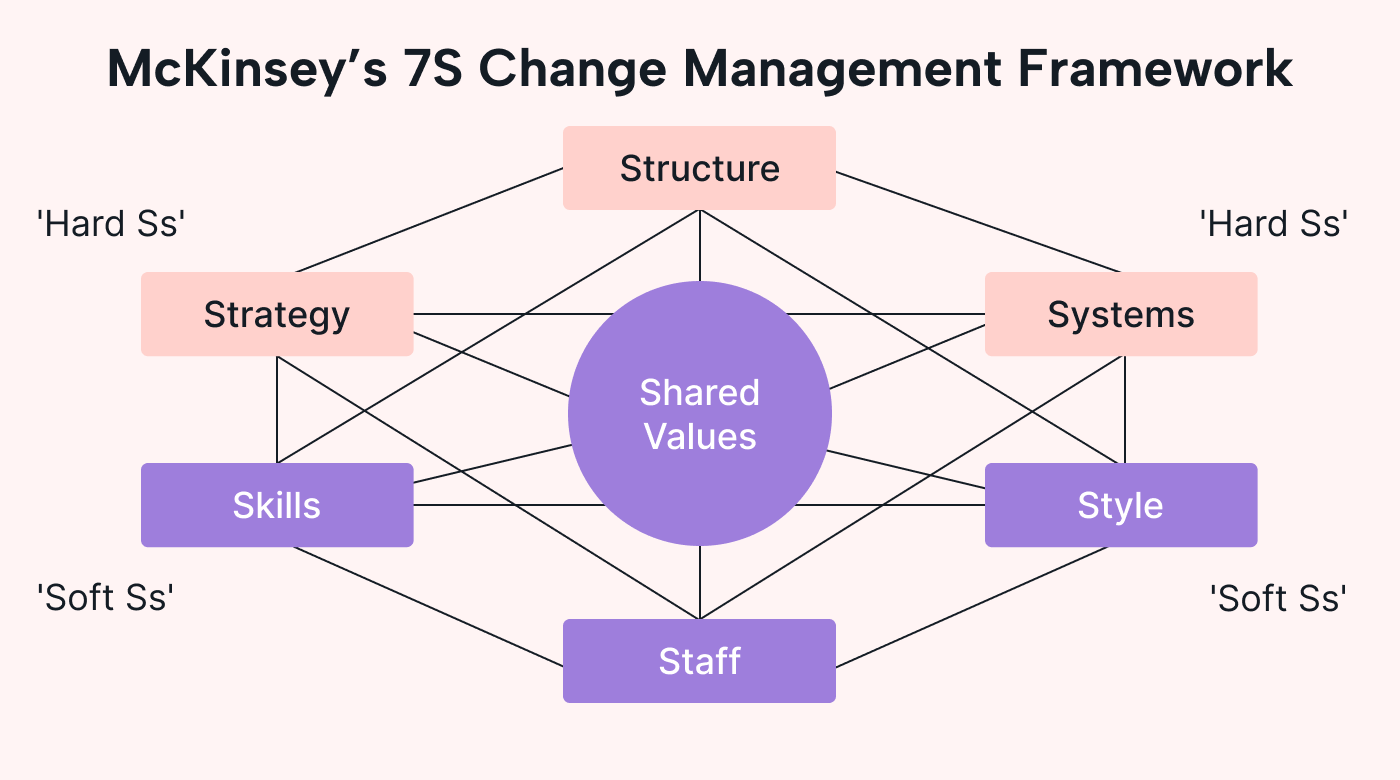 |
The McKinsey 7-s model includes seven elements that make up an organization.
The hard elements are objective and simple to determine and control and include:
- Strategy
- Structure
- System
The soft elements are more subjective and harder to change. They include:
- Shared values
- Staff
- Style
- Skills
The model assumes the seven elements are linked, and a change in one element affects the other.
Great for: if you know you need to change but are unsure what to do. Or you are adjusting other elements while a change is occurring.
Say the bakery grows rapidly from 20 employees to 100 employees. You know the company's staff, structure, and shared values will probably change, and you need a systematic approach to understand where to step in to affect the changes.
ADKAR change management framework
Jeffrey Hiatt’s ADKAR change framework is intended to help people accept change since change is usually more about how people respond to it than the actual changes.
The ADKAR model helps people move through change with distinct steps that help them understand and embrace it.
ADKAR stands for:
- Awareness: of the necessity of transformation
- Desire: to be part of and aid the change
- Knowledge: of the potential that the change holds
- Ability: to make the change
- Reinforcement: to maintain the change
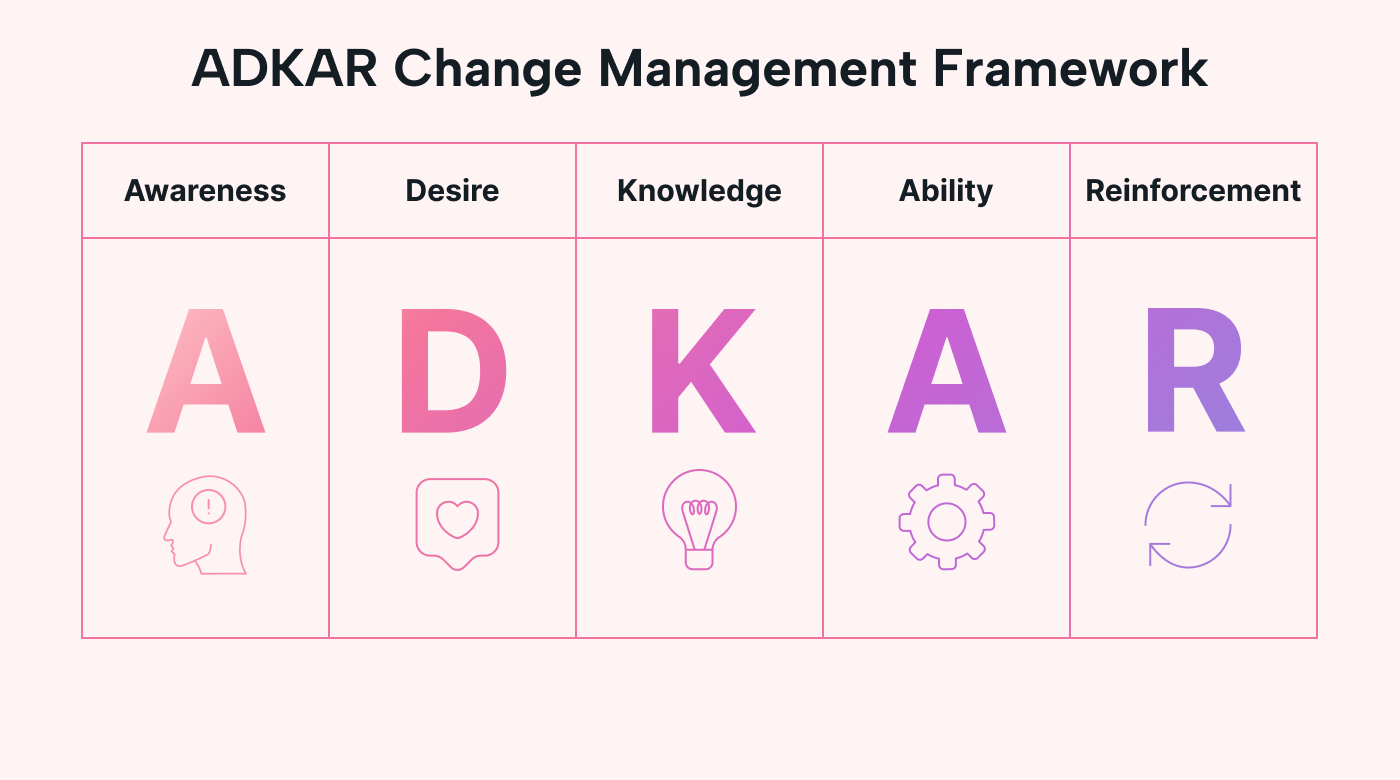 |
Great for: a people-focused approach to change management.
Applying the ADKAR framework to the bakery's new service could look like this:
- Creating awareness by showing the bakers that there are a lot of people looking for cake deliveries.
- Telling them about the new recipes they'll learn so that they desire the change.
- Explaining that the more recipes they learn, the more opportunities they'll have (knowledge).
- Investing in workshops to grow their ability to adapt to the workflow.
- Creating small wins and showing them that new change is effective (reinforcement).
3 tips to make change stick
Use these three tips to help beef up your change management framework.
Go Agile
Change is a long game, so it’s best to do it iteratively, which aligns perfectly with an Agile change management process.
Agile is, at its core, a change and adapt (to seek continuous improvement) methodology. It’s also about empowering employees on an individual level and collaboratively.
Agile frameworks like Scrum have ceremonies that can help you implement change:
- Daily stand-up: great for hashing out any blockers for change.
- Retrospective: can help you identify if the change is being adopted and, if not, what to do about it.
Create a communication and collaboration plan
Clear communication and collaboration are key to successful change management.
Creating a communications plan will help you focus on engaging your team. Your plan should:
- Create an engaging work culture
- Encourage two-way feedback
- Implement servant leadership
- Invest in employee growth
You’ll dramatically increase your chances of success with a systematic communication and collaboration approach.
Document and centralize everything
You'll want to document everything, including your "why" statement, wins, lessons learned, and questions. Since change is a long game, this will help keep everything front and center.
Of course, you’ll also want to keep these documents (and other information) in a central location (like project management software), so your team can access them anytime.
Tackle change with the right change management framework
One or a mix of these change management frameworks will help you set the boundaries for a successful change initiative. No matter how big (or small) the changes are, using the right tools can make your life much easier.
A powerful communication and resource management tool like Motion can help you keep your communication channels clear and transparent. This will help you drive away any doubts, misconceptions, or fears your team might have along the way.
Sign up for your 7-day free trial today.

